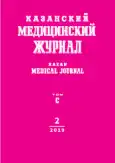Accidental hypothermia as a factor of microcirculatory disorders
- Authors: Lycheva NA1, Sedov AV1, Makushkina DA1, Shakhmatov II1, Vdovin VM1
-
Affiliations:
- Altai State Medical University
- Issue: Vol 100, No 2 (2019)
- Pages: 252-256
- Section: Experimental medicine
- URL: https://journals.rcsi.science/kazanmedj/article/view/11535
- DOI: https://doi.org/10.17816/KMJ2019-252
- ID: 11535
Cite item
Full Text
Abstract
Aim. To study the dynamics of indicators of microcirculation during a single episode of hypothermia of moderate degree in rats, both immediately after cessation of cooling, and in different periods of posthypothermia.
Methods. The study was performed on 25 Wistar rats. The animals were subjected to a single immersion cooling in water at a temperature of 5 °C until reaching a rectal temperature of 27-30 °C. Analysis of the microvasculature was carried out immediately upon reaching a moderate degree of hypothermia, 2, 5, 10 and 14 days after the cooling. The microcirculation parameters were estimated using a laser analyzer of capillary circulation LAKK-02 (SMO «Lazma», Russia) at a wavelength of 0.63 μm. The main parameters of microcirculation were recorded, and the amplitude-frequency spectrum of blood flow oscillations was analyzed.
Results. Immediately after reaching a moderate degree of hypothermia, vasospasm was recorded, which was confirmed by a decrease in the rate of perfusion and wave amplitudes of all frequency ranges. 2 days after stopping the cooling perfusion index returned to baseline, a decrease in amplitude of endothelial, vasomotor and respiratory waves was observed with an increase in pulse waves. On day 5, perfusion increased by 5 times was observed along with decreased amplitudes of the waves of all ranges. By day 10, the level of blood flow returned to its original values, and the wave amplitudes of all frequency ranges remained at the same low level. By day 14, a progressive decrease of the factors of bloodflow modulation was associated by the decrease of perfusion.
Conclusion. Single cooling to a moderate degree of hypothermia leads to a progressive decrease of tissue perfusion and deep inhibition of active and passive factors of bloodflow modulation.
Keywords
Full Text
##article.viewOnOriginalSite##About the authors
N A Lycheva
Altai State Medical University
Author for correspondence.
Email: natalia.lycheva@yandex.ru
Barnaul, Russia
A V Sedov
Altai State Medical University
Email: natalia.lycheva@yandex.ru
Barnaul, Russia
D A Makushkina
Altai State Medical University
Email: natalia.lycheva@yandex.ru
Barnaul, Russia
I I Shakhmatov
Altai State Medical University
Email: natalia.lycheva@yandex.ru
Barnaul, Russia
V M Vdovin
Altai State Medical University
Email: natalia.lycheva@yandex.ru
Barnaul, Russia
References
- Wu C.Y., Chan K., Cheng Y.-J. Effects of different types of fluid resuscitation for hemorrhagic shock on splanchnic organ microcirculation and renal reactive oxygen species formation. Crit. Care. 2015; (19): 434. DOI: 10.1186/
- s13054-015-1135-y.
- Lopatina A.B. Mechanisms of formation of adaptation. Mezhdunarodnyy nauchno-issledovatel'skiy zhurnal. 2016; (6): 51–52. (In Russ.)
- Bisschops L.A., Hoeven J.G., Mollnes T.E. Seventy-
- two hours of mild hypothermia after cardiac arrest is associated with a lowered inflammatory response during rewarming in a prospective observational study. Crit. Care. 2014; 18 (5): 546. doi: 10.1186/s13054-014-0546-5.
- Konnov D.Yu., Konnov Yu.A., Lukyanov S.A., Shapovalov K.G. Patterns of changes in microcirculation in acute general cold injury. Regionarnoe krovoobrashchenie i mikrotsirkulyatsiya. 2017; 16 (3): 26–30. (In Russ.)
- Koopmansa M., Kuipera M.A., Endemanb H. Microcirculatory perfusion and vascular reactivity are altered in post cardiac arrest patients, irrespective of target temperature management to 33 °C vs 36 °C. Resuscitation. 2015; (86): 14–18. doi: 10.1016/j.resuscitation.2014.09.025.
- Council Directive of 24 November 1986 on the Approximation of Laws, Regulations of the Member States Regarding the Protection of Animals Used for Experimental and Other Purposes Directive (86/609/EEC). Official Journal of the European Communities. L. 262; 1–29. https://eur-lex.europa.eu/legal-content/EN/ALL/?uri=CELEX%3A31986L0609 (access date: 18.10.2018).
- Konnov D.Yu., Malyarchikov A.V., Shapovalov K.G., Konnov V.A. Regularities of changes in microcirculation parameters and electrophysiological indicators of heart rhythm during critical hypothermia. Zabaykalskiy meditsinskiy vestnik. 2017; (4): 17–24. (In Russ.)
- Oleynyk G.A. Pathophysiology of cold shock. Meditsina neotlozhnykh sostoyaniy. 2013; (8): 16–21. (In Russ.)
- Vinokurov A.A., Alabovskiy V.V., Khamburov V.V., Maslov O.V. Diastolic dysfunction as a result of reversal of Nа+/Cа2+ metabolism in the event of a «calcium paradox» in the heart muscle. Nauchno-meditsinskiy vestnik tsentral'nogo Chernozem'ya. 2013; (2): 54–62. (In Russ.)
- Абрамович С.Г., Машанская А.В., Дробышев В.А., Долбилкин А.Ю. Микроциркуляция у здоровых людей
- и больных артериальной гипертонией. J. Siberian Med.
- Sci. 2013; (2): 51–57. [Abramovich S.G., Mashanskaya A.V., Drobyshev V.A., Dolbilkin A.Yu. Microcirculation in healthy people and patients with arterial hypertension.
- Journal of Siberian medical sciences. 2013; (2): 51–57. (In Russ.)]
- Basantsova N.Yu., Shishkin A.N., Tibekina L.M. Cerebrocardiac syndrome and its features in patients with acute cerebral circulatory disorders. Vestnik Sankt-Peterburgskogo universiteta. 2017; (12); (1): 31–47. (In Russ.)
- Kuznetsova V.L., Solov'eva A.G. Nitric oxide: properties, biological role, mechanisms of action. Sovremennye problemy nauki i obrazovaniya. 2015; (4): 462. (In Russ.)
- Vinnik Yu.S., Yur'eva M.Yu., Teplyakova O.V. et al. The value of endothelial dysfunction in the pathogenesis of local cold injury. Russkiy meditsinskiy zhurnal. 2014; 22 (31): 2204–2206. (In Russ.)
- Shapovalov K.G. The role of endothelial dysfunction in the alteration of tissues with local cold injury. Tromboz, gemostaz i reologiya. 2016; (4): 26–30. (In Russ.)
- Lycheva N.A., Shakhmatov I.I., Blazhko A.A., Sedov A.V. Modulating effects of moderate hypothermia on the state of the hemostatic system and microvasculation in rats. Sovremennye problemy nauki i obrazovaniya. 2016; (5): 83. (In Russ.)
- Shapkin Yu.G., Stekol'nikov N.Yu., Gamzatova P.K., Odnokozova Yu.S. Endothelial dysfunction in the remote period of cold injury. Vestnik ehksperimentalnoy i klinicheskoy khirurgii. 2014; 7 (4): 359–363. (In Russ.)
- Beyer A.M., Freed J.K., Durand M.J. Critical role for telomerase in the mechanism of fow-mediated dilation in the human microcirculation. Circ. Res. 2016; 118 (5): 856–866. doi: 10.1161/CIRCRESAHA.115.307918.
Supplementary files






